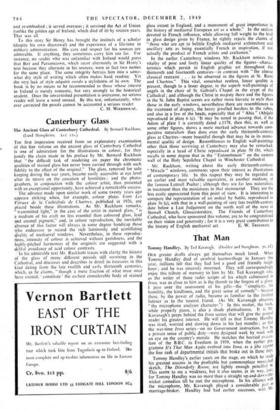Irish Armed Forces The Irish Militia, t793-18t6. By Sir Henry
McAnally. (Eyre and Spottiswoode. 213.) IN retrospect the second half of the eighteenth century seems almost a golden age in Ireland. The Irish had a parliament of their own, a capital of outstanding beauty and distinction, a material prosperity which, though far short of ideal, compares favourably with almest any other period, and, above all, a social cohesion which only the unforgivable interference of successive generations of English poli- ticians could have broken. Ireland also succeeded for a brief space in raising its own armed forces ; hence the present book, which, being a social as well as a military study, presents incidentally an agreeable and effective picture of an age when there was almost no ill-feeling between sect and sect or between class and class. Few Englishmen pay much attention to Ireland in this period, perhaps from a legitimate sense of shame ; few history books even record the repulsion of a French invasion by Irish troops in 179; But it would be well for us to give more attention to the year' in which our ancestors, fresh from the loss of their American colonies sent the same men to Ireland to sow the seeds from which sprang the bitter rivalry between Irish Nationalism and the Orange Order Sir Henry McAnally has done our history a service by the dm- passionate integrity with which he approaches the task. The out- line of the story is short and simple. The Irish Militia was estab- lished as a territorial army, on the English model, in succession I 10 Charlemont's volunteers by-Act of Parliament in 1793. It gre.A n strength and purpose ; it marched and counter-marched , it sup pressed a rebellion and fought an invasion ; it was twice disembodied
and re-embodied ; it served overseas ; it survived the Act of Union (unlike the golden age of Ireland, which died of it) by sixteen years. That was all.
To this story Sir Henry has brought the instincts of a scholar (despite his own disavowal) and the experience of a life-time in military administration. His care and respect for his sources are admirable. If anything, they sometimes carry him too far. For instance, no reader who was unfamiliar with Ireland would guess that Birr and Parsonstown, which recur alternately in Sir Henry's text because they alternate in his sources, were in fact two names for the same place. The same integrity betrays him into a soniz- what dry style of writing which often makes hard reading. Yet the very lack of style adquirit ettndo a stylishness of its own. The book is by no means to be recommended to those whose interest in Ireland is merely romantic, but very strongly to the historical student. Once the unvarnished presentation is overcome, no serious reader will leave a word unread. By this test: unfortunately, who- ever corrected the proofs cannot be accounted a serious reader C. M. WOODHOUSE.



































 Previous page
Previous page